Quarterly Banking Profile - Second Quarter 2024
Good morning and welcome to our release of second quarter 2024 performance results for FDIC-insured institutions.
The banking industry continued to show resilience in the second quarter. Net income increased and asset quality metrics remained generally favorable. However, the industry continued to report weakness in several loan portfolios, which we are monitoring closely, and the net charge-off rate on loans increased during the quarter.
The banking industry’s net income of $71.5 billion in the second quarter was an increase of $7.3 billion, or 11.4 percent, from the prior quarter. This is mainly due to one-time items including the absence of an FDIC special assessment expense, one-time gains on equity security transactions, and the sale of an institution’s insurance division.1 These benefits to the industry’s net income were partially offset by realized losses on the sale of bond securities and higher provision expenses.
Community banks reported net income of $6.4 billion, a quarterly increase of 1.1 percent, driven by higher net interest income and noninterest income that more than offset higher noninterest and provision expenses.
The net interest margin increased for all size groups except for the largest banks as the change in the yield on loans exceeded the change in the cost of deposits. The net interest margin for community banks increased 7 basis points quarter over quarter, reversing a four-quarter declining trend.
However, as a result of the 4 basis point decline in the margin for the largest banks, those with assets over $250 billion, the industry’s net interest margin in the aggregate declined 1 basis point to 3.16 percent and remained below the pre-pandemic average of 3.25 percent after following below that level last quarter.2
Unrealized losses on available-for-sale and held-to-maturity securities declined $4 billion to $513 billion in the second quarter. Interest rates rose modestly during the quarter, but the resulting increase in unrealized losses on fixed-rate bonds was more than offset by the sale of bonds by some large banks that resulted in realized losses. This is the tenth straight quarter that the industry has reported unusually high unrealized losses since the Federal Reserve began to raise interest rates in first quarter 2022.
The industry’s total loans increased by $126 billion, or 1.0 percent, in the second quarter. Most of the increase was reported in loans to non-depository financial institutions, but much of that growth appears to be from the reclassification of existing loans from other loan categories. Consumer loans, mostly credit card loans, also drove the quarterly increase, and all other major loan categories except construction and development loans experienced quarterly growth. The industry’s annual rate of loan growth increased in the second quarter to 2.0 percent.
Total loans at community banks increased 1.7 percent from the prior quarter and 6.3 percent from the prior year, led by CRE and residential mortgage loans.3
Asset quality metrics were generally favorable despite continued weakness in CRE and credit card portfolios, as well as weakness in multifamily loans. The industry’s overall noncurrent loan rate remained unchanged from the prior quarter at 0.91 percent, a level still well below the pre-pandemic average noncurrent rate of 1.28 percent.4 But the industry’s noncurrent CRE and multifamily noncurrent ratios increased quarter over quarter, and the credit card noncurrent rate remained elevated.
Noncurrent loan balances continued to increase in the industry’s non-owner occupied CRE loan portfolio. Weak demand for office space continues to soften property values, and higher interest rates are affecting the repayment and refinancing ability of office and other types of non-owner occupied CRE loans. As a result, the industry’s noncurrent rate for non-owner occupied CRE loans in the second quarter was at its highest level since third quarter 2013.
The increase in noncurrent non-owner occupied loans was largely driven by office loans at banks with more than $250 billion in assets. However, these banks tend to have lower concentrations of such loans in relation to total assets and capital than smaller institutions, mitigating the overall risk. The next tier of banks, those with between $10 billion and $250 billion in assets, have greater concentrations in non-owner occupied CRE loans and reported some stress in these loans compared to pre-pandemic noncurrent rates.
Driven in part by write-downs on credit cards, the industry’s quarterly net charge-off rate increased to 0.68 percent, 20 basis points higher than the prior year’s rate and also 20 basis points higher than the pre-pandemic average. The credit card net charge-off rate increased again in the second quarter and was the highest rate reported since third quarter 2011.
Domestic deposits decreased this quarter by $198 billion, or 1.1 percent, a rate well below the pre-pandemic average second quarter growth of 0.2 percent. Both savings and transaction deposits declined from the prior quarter, with growth in small time deposits partially offsetting the declines. Brokered deposits decreased for the second straight quarter, down $10 billion (0.8 percent) from the prior quarter. Banks with over $250 billion in assets reported much of the decline in domestic deposits, in part from tax payment outflows. These large banks reported lower uninsured deposits in the second quarter, while banks with assets less than $250 billion reported higher uninsured deposit levels.
The number of banks on the Problem Bank List, which encompasses banks that have a CAMELS composite rating of “4” or “5,” increased from 63 in first quarter 2024 to 66 in the second quarter. The number of problem banks represented 1.5 percent of total banks, which was within the normal range for non-crisis periods of 1 to 2 percent of all banks. Total assets held by problem banks increased $1 billion to $83 billion during the quarter.
The Deposit Insurance Fund (DIF) balance was $129 billion on June 30, up $4 billion from the end of the first quarter. Insured deposits decreased by 0.9 percent, which was slower than the typical rate of growth for a second quarter. As a result of the increase in the DIF balance and the lower level of insured deposits, the reserve ratio, or the fund balance relative to insured deposits, increased by 4 basis points to 1.21 percent. The reserve ratio currently remains on track to reach the 1.35 percent minimum reserve ratio by the statutory deadline of September 30, 2028.
In conclusion, the banking industry continued to show resilience in the second quarter. However, the industry still faces significant downside risks from uncertainty in the economic outlook, market interest rates, and geopolitical events. These issues could cause credit quality, earnings, and liquidity challenges for the industry. In addition, weakness in certain loan portfolios, particularly office properties, credit cards, and multifamily loans, continues to warrant monitoring. These issues, together with funding and margin pressures, will remain matters of ongoing supervisory attention by the FDIC.
Thank you.
I am happy to take your questions.
Chart 1:
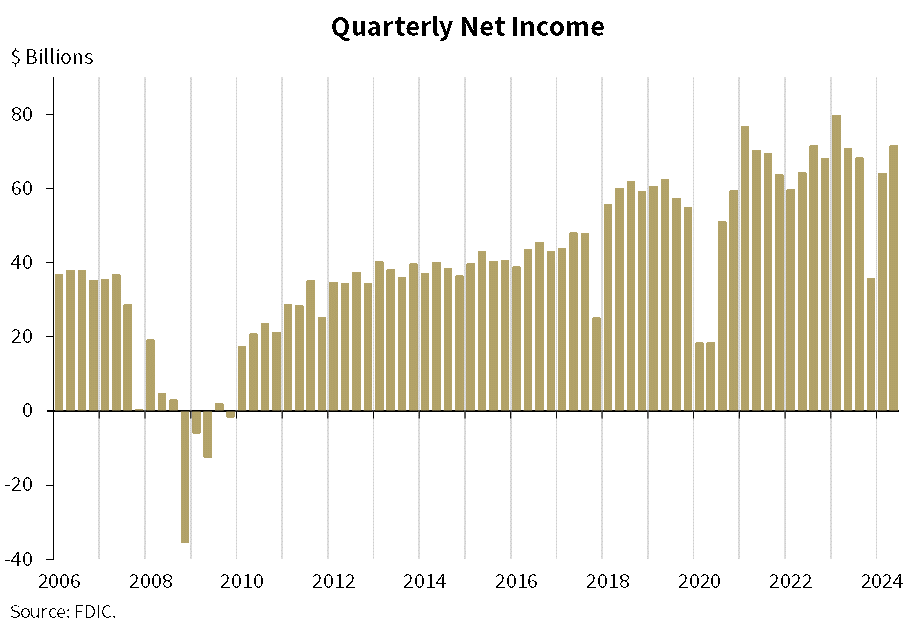
This chart shows that the banking industry reported quarterly net income of $71.5 billion, an increase of $7.3 billion, or 11.4 percent, from the prior quarter. A decline in noninterest expense (down $3.6 billion, or 2.4 percent) along with higher noninterest income (up $1.2 billion, or 1.5 percent) and higher gains on the sale of securities (up $937 million) were the primary drivers of the increase in net income.
Community bank quarterly net income increased 1.1 percent from the prior quarter to $6.4 billion, driven by higher net interest income and noninterest income that offset higher noninterest and provision expense.
Chart 2:
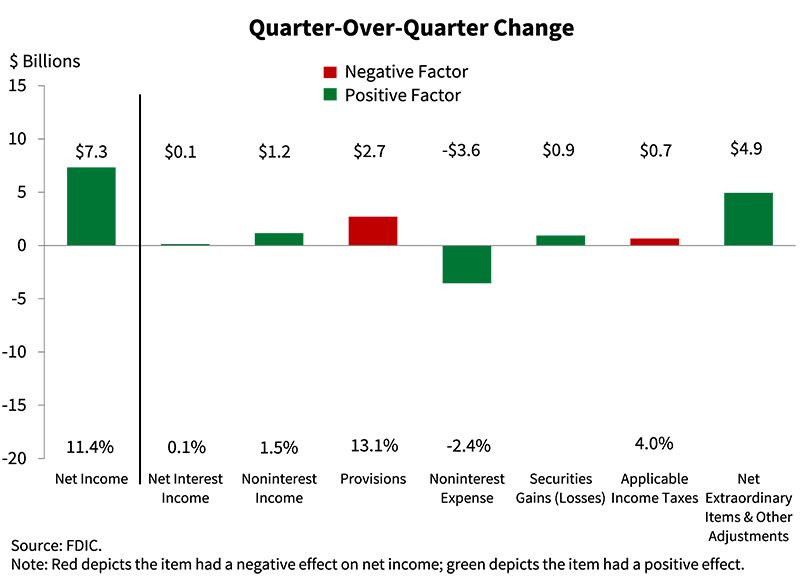
This chart shows the breakdown of the changes in industry net income quarter over quarter.
The quarterly increases in net income were largely driven by nonrecurring items including: the absence of expenses related to the FDIC special assessment this quarter, compared to an estimated $4 billion last quarter; approximately $10 billion in one-time gains on equity security transactions; and the sale of an institution’s insurance division that resulted in an after-tax $4.9 billion gain reported as an extraordinary event. These benefits to net income were partially offset by the sale of bond securities at a loss and an increase in provision expense.
Chart 3:

The next chart shows that the industry’s provision expense was $23.3 billion in the second quarter, up $2.7 billion from the first quarter. The increase in provision expense was driven by the largest institutions and reflects quarterly loan growth, deterioration in office markets, and high credit card charge-offs. The industry’s provision expense has been higher than the pre-pandemic average for the past eight quarters.
Chart 4:

The next chart shows the average net interest margin (NIM) for the industry and the five asset size groups for which the QBP reports. The industry’s NIM fell 1 basis point from last quarter to 3.16 percent. The NIM increased for all size groups except banks with assets over $250 billion, whose NIM declined by 4 basis points. The industry’s NIM remained below its pre-pandemic average of 3.25 percent for the second straight quarter.
The community bank NIM increased to 3.30 percent, up 7 basis points from prior quarter, reversing a four-quarter declining trend. Still, the community bank NIM remained well below the pre-pandemic average of 3.63 percent.
Chart 5:
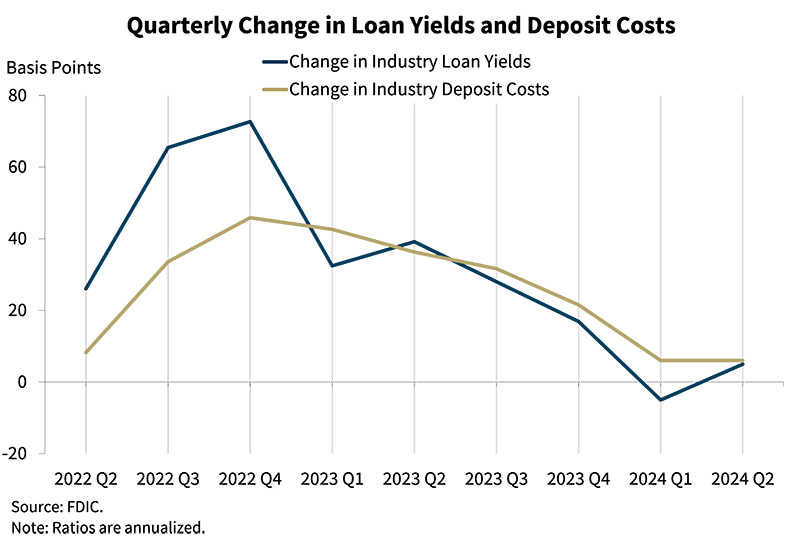
The next chart shows the quarter-over-quarter changes in the industry’s average yield on loans and average cost of deposits. During the quarter, deposit costs increased 6 basis points and loan yields increased 5 basis points, which helps to explain the small decline in the industry’s NIM this quarter. Deposit costs have increased faster than loan yields for four consecutive quarters.
Community banks’ NIM increase in the second quarter was fueled by a 14 basis-point increase in loan yields outpacing a 10 basis-point increase in deposit costs.
Chart 6:
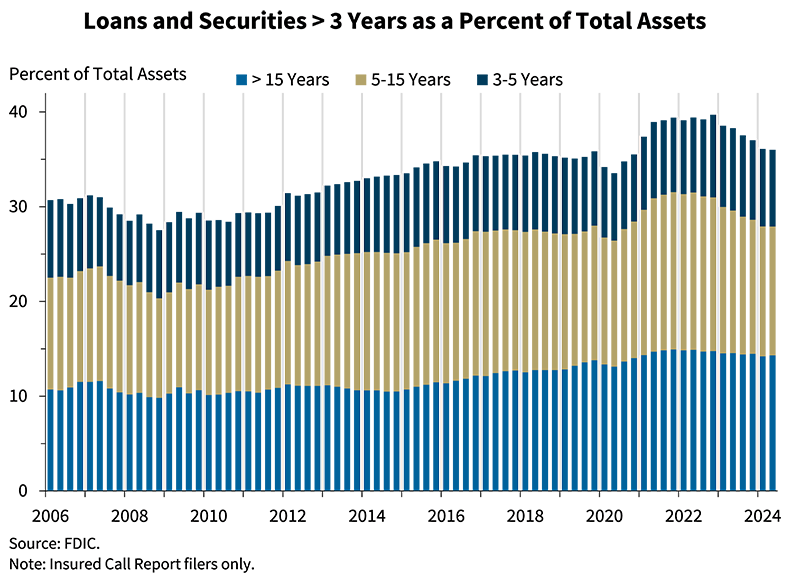
This chart shows that the banking industry’s share of longer-term loans and securities fell for the sixth consecutive quarter to 35.9 percent after peaking at 39.7 percent in fourth quarter 2022. The industry’s share of longer-term assets is still modestly above the pre-pandemic average of 35.0 percent.
Community banks’ share of longer-term loans and securities was 48.1 percent in second quarter 2024, down from 49.5 percent last quarter and below the pre-pandemic average of 48.8 percent.
Chart 7:
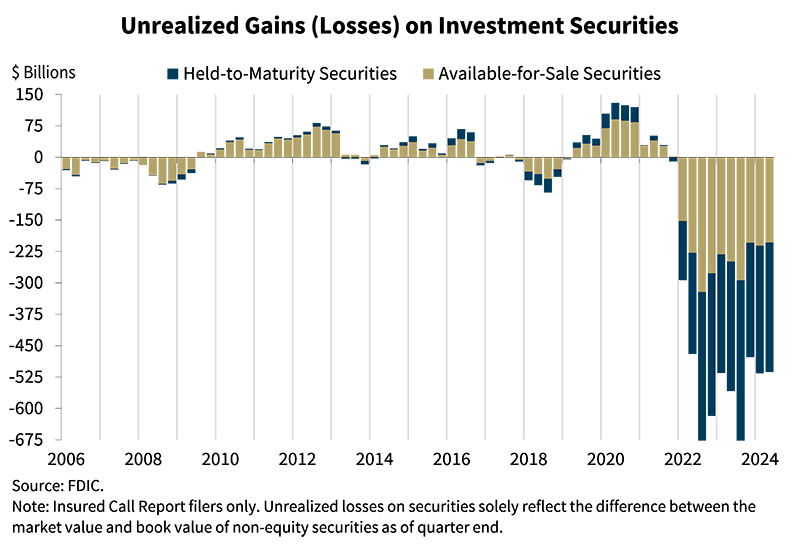
The next chart shows the level of unrealized losses on held-to-maturity and available-for-sale securities portfolios. Total unrealized losses of $512.9 billion decreased $3.6 billion (0.7 percent) from the prior quarter. Interest rates increased modestly in the second quarter, putting downward pressure on bond prices, but the resulting increase in unrealized losses was more than offset by the sale of bonds by several large banks that resulted in substantial realized losses.
This is the tenth straight quarter of unusually high unrealized losses for the industry since the Federal Reserve began to raise interest rates in first quarter 2022.
Chart 8:
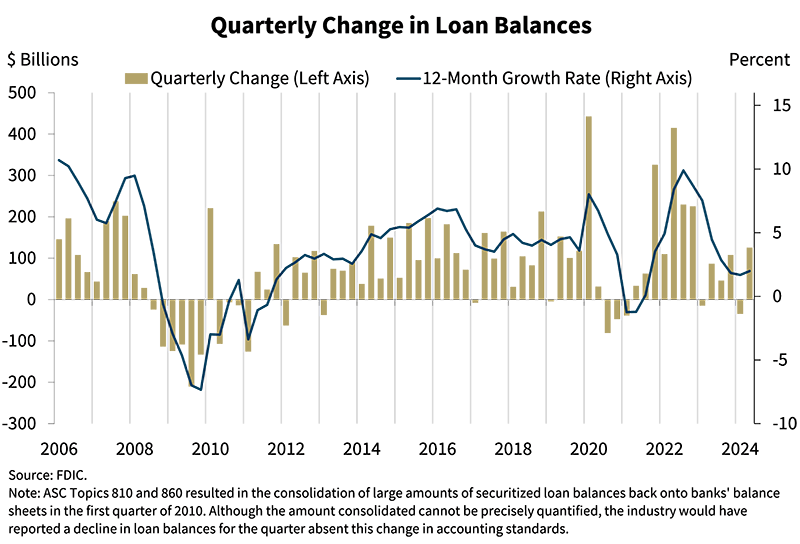
The next chart shows the dollar change in loan balances on a quarterly and annual basis. The industry reported an increase in total loans of $125.8 billion, or 1.0 percent, in the second quarter. Most of the increase was reported in loans to non-depository financial institutions, but much of that growth appears to be the reclassification of existing loans from other loan categories. Consumer loans, mostly credit card loans, also drove to the quarterly increase, and all other major loan categories except construction and development loans showed quarterly growth.
The industry’s annual rate of loan growth increased in the second quarter to 2.0 percent. The annual increase was also led by loans to non-depository financial institutions, again likely due to the reclassification of existing loans, as well as growth in credit card loans and adjustable rate 1-4 family residential mortgage loans.
Total loans at community banks increased 1.7 percent from the prior quarter and 6.3 percent from the prior year. Growth in CRE loans and 1-4 family residential mortgage loan balances drove both the quarterly and annual increases in loan and lease balances.
Chart 9:

The next chart shows that asset quality metrics for the industry remained generally favorable despite deterioration in non-owner occupied CRE, credit card, and multifamily portfolios. The overall noncurrent loan rate remained unchanged from the prior quarter at 0.91 percent, a level still well below the pre-pandemic average noncurrent rate of 1.28 percent. But the industry’s noncurrent CRE and multifamily noncurrent rates increased quarter over quarter, and its credit card noncurrent rate remains elevated.
The quarterly increase in noncurrent CRE loans was led by higher noncurrent rates for non-owner-occupied CRE loans. The noncurrent rate for non-owner occupied CRE loans of 1.77 percent was at its highest level since third quarter 2013, driven by office portfolios at the largest banks (see the next chart). The multifamily noncurrent rate of 0.50 percent was also the highest since third quarter 2014. The noncurrent rates for credit cards over the past three quarters were the highest since fourth quarter 2011.
The quarterly net charge-off rate of 0.68 percent increased 3 basis points from last quarter and was 20 basis points higher than the year-ago quarter. This net charge-off rate was also 20 basis points higher than the pre-pandemic average rate. CRE and credit card write-downs drove the annual increase in net charge-off balances. Net charge-offs for CRE loans increased by 12 basis points quarter over quarter to 0.38 percent, the highest rate reported since first quarter 2013. The credit card net charge-off rate was 4.82 percent in the second quarter, up 12 basis points quarter over quarter to a rate 134 basis points higher than the pre-pandemic average. The second quarter net charge-off rate for credit cards was the highest rate reported since third quarter 2011.
Chart 10:
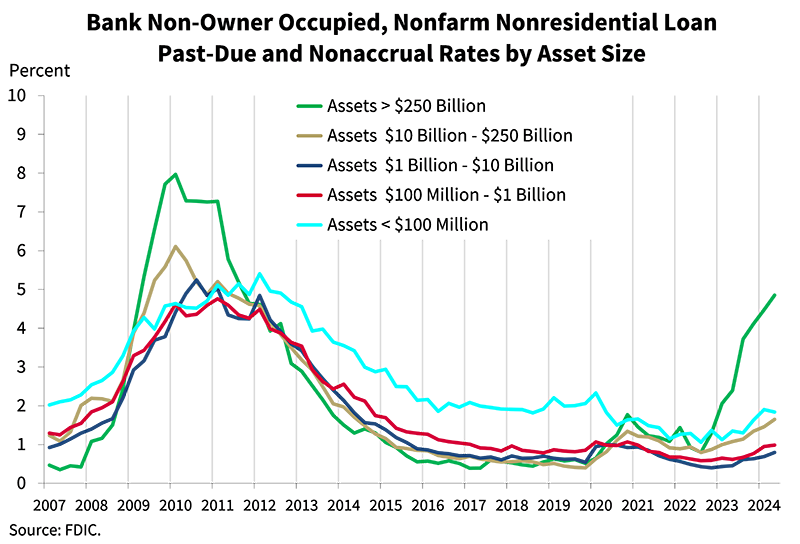
Looking at more detailed CRE segments, the upward trend in past due and nonaccrual (PDNA) non-owner-occupied property loans continued in the second quarter. The industry’s volume of PDNA non-owner-occupied CRE loans increased $2.0 billion, or 9.2 percent, quarter over quarter. As seen in this chart, the greatest weakness in non-owner-occupied CRE loans continued to be reported by the largest banks (those with greater than $250 billion in assets). These banks reported a PDNA rate of 4.85 percent, well above their pre-pandemic average rate of 0.59 percent. However, these large banks tend to have lower concentrations of such loans in relation to total assets and capital than smaller institutions, mitigating the overall risk.
The next tier of banks, those with between $10 billion and $250 billion in assets, have greater concentrations in non-owner occupied CRE loans and reported some stress in this portfolio. This cohort’s non-owner occupied PDNA rate was 1.65 percent in the second quarter, up from 1.46 percent in the first quarter and above its pre-pandemic average of 0.66 percent. Banks in size cohorts below $10 billion in assets reported non-owner occupied PDNA ratios at or near their pre-pandemic averages.
Chart 11:
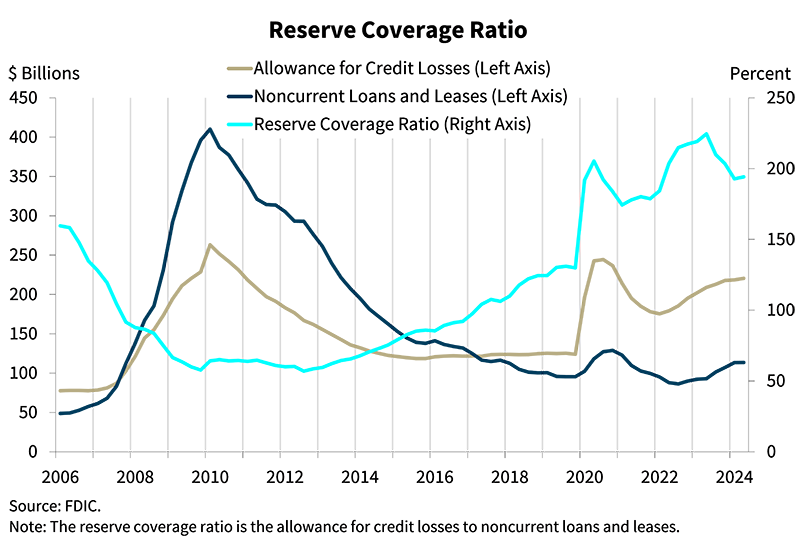
The next chart shows that the allowance for credit losses increased at a faster pace than the noncurrent loan balances, resulting in an increase in the reserve coverage ratio. The ratio of the allowance for credit losses to noncurrent loans increased from 192.8 percent in the first quarter to 194.2 percent this quarter. This is still a much higher coverage ratio than the pre-pandemic average.
The reserve coverage ratio at community banks was 200.3 percent, down modestly quarter over quarter as noncurrent loan balances increased faster than the allowance for credit losses.
Chart 12:
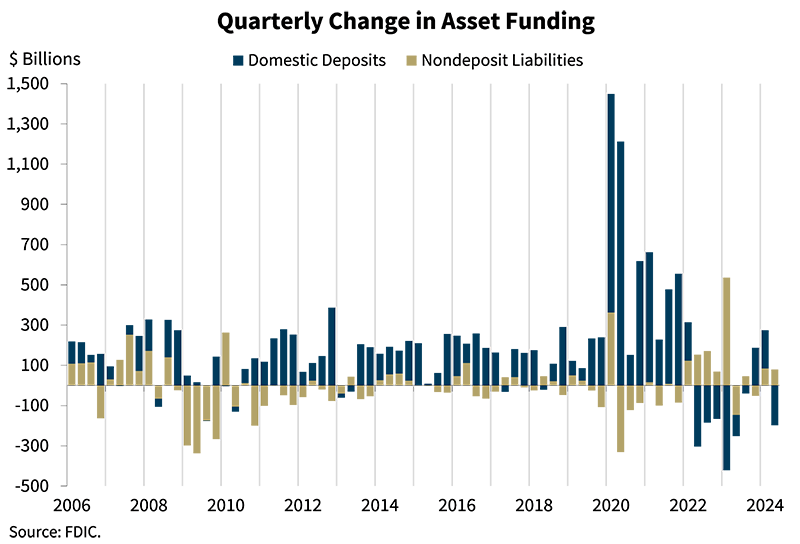
The next chart shows that domestic deposits decreased $197.7 billion, or 1.1 percent, during the second quarter, below the pre-pandemic average second quarter growth of 0.2 percent. Both savings and transaction deposits declined from the prior quarter, with growth in small time deposits partially offsetting the declines. Brokered deposits decreased for the second straight quarter, down $10.1 billion (0.8 percent) from the prior quarter.
Insured deposits declined $96.0 billion, or 0.9 percent, quarter over quarter. Uninsured deposits decreased $50.4 billion, or 0.7 percent. The pre-pandemic average growth for insured deposits in the second quarter was flat, while uninsured deposits experienced slight growth. Banks with over $250 billion in assets experienced much of the decline in deposits, in part from tax payment outflows. These large banks reported lower uninsured deposits in the second quarter, while banks with assets less than $250 billion reported higher uninsured deposit levels.
Nondeposit liabilities increased by $79 billion from the prior quarter, driven by an increase in fed funds purchased and repurchase agreements.
Chart 13:
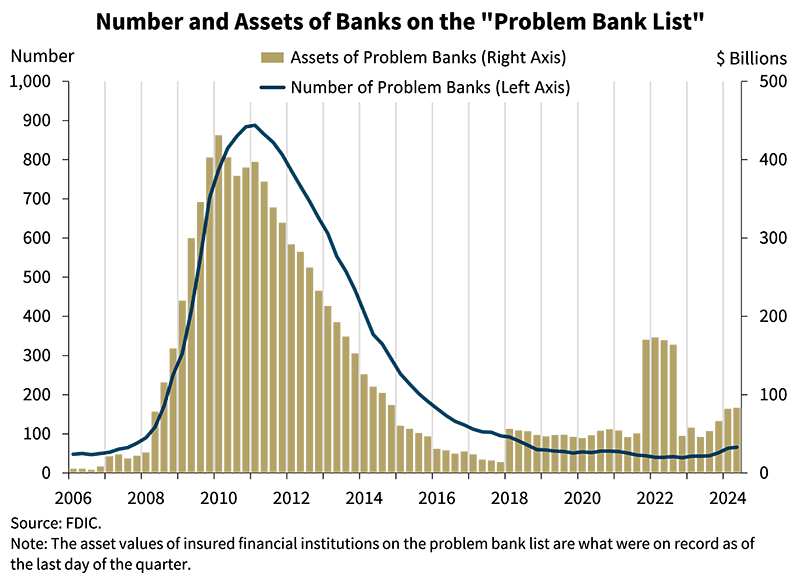
This chart shows the number and total assets of banks on the FDIC’s “Problem Bank List.” Banks on this list have a CAMELS composite rating of “4” or “5” due to financial, operational, or managerial weaknesses, or a combination of such issues. The number of banks on the list increased from 63 in first quarter 2024 to 66 in second quarter 2024. The number of problem banks represent 1.5 percent of total banks, which is within the normal range for non-crisis periods of 1 to 2 percent of all banks. Total assets held by problem banks increased $1.3 billion to $83.4 billion. One bank failed during the second quarter.
Chart 14:

The final chart shows that the DIF balance was $129.2 billion on June 30, 2024, up approximately $3.9 billion from the first quarter. Assessment revenue continued to be the primary driver of the increase, adding $3.2 billion to the DIF balance. Interest earned on investment securities and negative provisions for insurance losses also contributed a combined $1.3 billion to growth in the fund, partially offset by operating expenses of $609 million.
The net change in the DIF balance does not include the cost of protecting uninsured depositors pursuant to the systemic risk determination made for the two bank failures that occurred in March 2023, as the FDIC is required by statute to recover those losses through a special assessment. As of June 30, 2024, the total loss estimate for Silicon Valley Bank and Signature Bank was $22.4 billion, of which $19.2 billion is attributable to the protection of uninsured depositors pursuant to the systemic risk determination and will be recovered through the special assessment. As with all receiverships, loss estimates will be periodically adjusted as the FDIC as receiver of failed banks sells assets, satisfies liabilities, and incurs receivership expenses.
Insured deposits decreased by 0.9 percent during the second quarter, and year-over-year insured deposit growth was 0.8 percent. The reserve ratio increased by 4 basis points in the second quarter to 1.21 percent and is 10 basis points higher than a year ago.
The FDIC adopted a DIF Restoration Plan on September 15, 2020, to return the reserve ratio to the statutory minimum of 1.35 percent by September 30, 2028, as required by law. Based on FDIC projections, the reserve ratio remains on track to reach 1.35 percent by the statutory deadline. The FDIC will continue to monitor factors affecting the reserve ratio, including but not limited to, insured deposit growth and potential losses due to bank failures and related reserves.
In conclusion, the banking industry continued to show resilience in the second quarter as net income increased and asset quality metrics remained generally favorable.
However, uncertainty in the economic outlook, market interest rates, and geopolitical events, along with continuing weakness in some bank loan portfolios, pose significant downside risks to the banking industry. These issues, together with funding and margin pressures, will be matters of close supervisory attention by the FDIC.
| 1 | Estimated losses attributable to the protection of uninsured depositors pursuant to the systemic risk determination for Silicon Valley Bank and Signature Bank, and that will be recovered through the FDIC special assessment, were $19.2 billion as of June 30, 2024, unchanged from March 31, 2024. The industry reported approximately $4 billion in additional expense for the special assessment in first quarter 2024, and no expense in the second quarter. |
| 2 | The “pre-pandemic average” in this statement is calculated as the average from first quarter 2015 through fourth quarter 2019. |
| 3 | In this statement, the term “commercial real estate loans,” or CRE loans, is used to describe nonfarm, nonresidential loans. |
| 4 | Noncurrent loans are those that are 90 or more days past due or are on nonaccrual status. |
